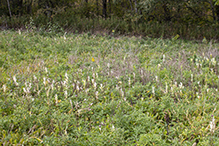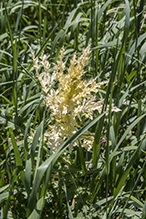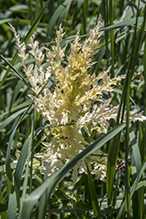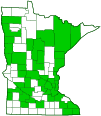apical chlorosis of Canada thistle (Pst)
(Pseudomonas syringae pv. tagetis)
Conservation • Description • Hosts • Ecology • Use • Distribution • Taxonomy
|
|
|||||||||||||
Description |
Outside of a laboratory, a bacterium is recognized only by the symptoms it produces in its host. Apical chlorosis of Canada thistle (Pst) (Pseudomonas syringae pv. tagetis) is a bacterium that infects some plants in the aster (Asteraceae) family. It produces the substance tagetitoxin, which blocks the production of chloroplasts, preventing photosynthesis. This results in whitened plant growth (chlorosis) on only the upper portion of the plant, stunted growth, fewer shoots, and inhibition of flowering. |
Similar Species |
Hosts |
Plants in the Aster (Asteraceae) family, including Canada thistle, common dandelion, common sunflower, common ragweed, giant ragweed, and Jerusalem artichoke. |
Ecology |
Season |
Symptoms most noticeable from June to September |
Use |
Researchers at the University of Minnesota conducted a study in 2002 to assess the viability of using Pst as a biological control agent for Canada thistle. |
Distribution |
||
|
Sources |
|
| 6/30/2025 | ||
Occurrence |
||
Common |
||
Taxonomy |
|
Kingdom |
Bacteria |
Phylum |
Proteobacteria |
Class |
Gammaproteobacteria |
Order |
Pseudomonadales |
Family |
Pseudomonadaceae |
Genus |
Pseudomonas |
Species |
Pseudomonas syringae (bacterial speck) |
Subordinate Taxa |
|
|
|
Synonyms |
|
|
|
Common Names |
|
apical chlorosis apical chlorosis of Canada thistle bacterial speck PST white‐colour disease of Canadian thistle (UK) |
|
Visitor Photos |
||
Share your photo of this bacteria. |
||
This button not working for you? |
||
|
||
MinnesotaSeasons.com Photos |
||
 |
 |
|
 |
 |

Slideshows |
|

Visitor Videos |
||
Share your video of this bacteria. |
||
This button not working for you? |
||
|
Other Videos |
||
|

Visitor Sightings |
||
Report a sighting of this bacteria. |
||
This button not working for you? |
||
|
|
MinnesotaSeasons.com Sightings |
||

Created: 4/12/2018 Last Updated: © MinnesotaSeasons.com. All rights reserved. |
